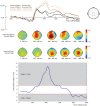Using goal- and grip-related information for understanding the correctness of other's actions: an ERP study
- PMID: 22606261
- PMCID: PMC3350525
- DOI: 10.1371/journal.pone.0036450
Using goal- and grip-related information for understanding the correctness of other's actions: an ERP study
Abstract
Detecting errors in other's actions is of pivotal importance for joint action, competitive behavior and observational learning. Although many studies have focused on the neural mechanisms involved in detecting low-level errors, relatively little is known about error-detection in everyday situations. The present study aimed to identify the functional and neural mechanisms whereby we understand the correctness of other's actions involving well-known objects (e.g. pouring coffee in a cup). Participants observed action sequences in which the correctness of the object grasped and the grip applied to a pair of objects were independently manipulated. Observation of object violations (e.g. grasping the empty cup instead of the coffee pot) resulted in a stronger P3-effect than observation of grip errors (e.g. grasping the coffee pot at the upper part instead of the handle), likely reflecting a reorienting response, directing attention to the relevant location. Following the P3-effect, a parietal slow wave positivity was observed that persisted for grip-errors, likely reflecting the detection of an incorrect hand-object interaction. These findings provide new insight in the functional significance of the neurophysiological markers associated with the observation of incorrect actions and suggest that the P3-effect and the subsequent parietal slow wave positivity may reflect the detection of errors at different levels in the action hierarchy. Thereby this study elucidates the cognitive processes that support the detection of action violations in the selection of objects and grips.
Conflict of interest statement
Figures




References
-
- Manthey S, Schubotz RI, von Cramon DY. Premotor cortex in observing erroneous action: an fMRI study. Brain Res Cogn Brain Res. 2003;15:296–307. - PubMed
-
- Newman-Norlund R, van Schie HT, van Hoek ME, Cuijpers RH, Bekkering H. The role of inferior frontal and parietal areas in differentiating meaningful and meaningless object-directed actions. Brain Res. 2010;1315:63–74. - PubMed
-
- Koelewijn T, van Schie HT, Bekkering H, Oostenveld R, Jensen O. Motor-cortical beta oscillations are modulated by correctness of observed action. Neuroimage. 2008;40:767–775. - PubMed
-
- Stapel JC, Hunnius S, van Elk M, Bekkering H. Soc Neurosci; 2010. Motor activation during observation of unusual versus ordinary actions in infancy. pp. 1–10. - PubMed
Publication types
MeSH terms
LinkOut - more resources
Full Text Sources

